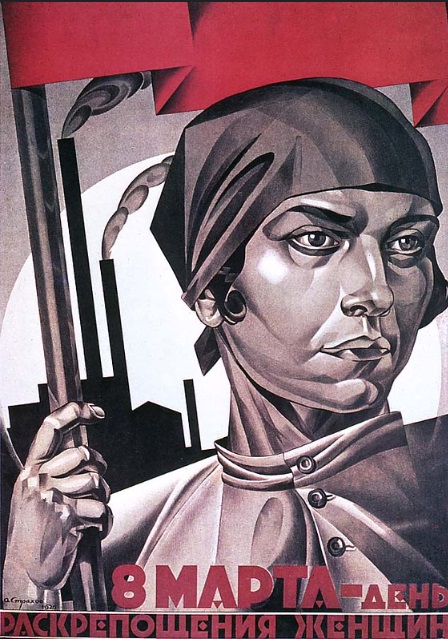|
|
|
Women in the Bolshevik Russia
The social and economic reforms promised by the Bolshevik Revolution of 1917 included the promise of improvements to the political and social status and rights of women. Even before the Revolution, Bolshevik women such as Nadya Krupskaya, Alexandra Kollontai and Inessa Armand and were organizing party groups, writing and distributing journals, leading strikes and working for women's libeation. One of the first decrees after the October Revolution was the 1917 Decree on Women's Rights, which granted women legal equality with men, including the right to vote and hold public office. The 1917 Code on Marriage, Family, and Guardianship promised work opportunities and publicly funded day care. Additionally, the Bolsheviks legalised divorce and abortion, giving women the opportunity to escape from the straightjacket of ‘wife-and-mother’. Women also gained from other progressive legislation – notably education and labour laws. Although you may read it in some accounts, it is NOT true that the Bolsheviks 'nationalised' unmarried women, making them 'the property of the state' – that was an anti-communist propaganda lie which still, somehow, continues to do the rounds. A Department for the Protection of Mother and Child was created (1917), and the first National Women’s Congress was held (1918). The Zhenotdel, or ‘Women's Bureau’ of the Communist Party, was established in 1919 to mobilize women and achieve their emancipation. Under the leadership of Armand and Kollontai, the Zhenotdel worked to improve women's education, employment opportunities, and healthcare. It also focused on issues such as childcare and communal living arrangements to relieve women from domestic burdens. During the Russian Civil War, 20,000 women trained as Red Nurses, 30,000 served as administrative workers, and 60,000 fought as soldiers in the Red Army. In addition, the so-called 'War Communism' and later the New Economic Policy (NEP) meant that many women went to work in factories and other industries, encouraged by State policies promoting gender equality in employment. The feminist historian Barbara Clements suggests that this actually worked against the goal of female liberation. Moreover, the Civil War led to significant hardships, including unemployment and inadequate living conditions, which disproportionately affected women. Travelling round the country, Kollontai found that, as time went on, women were becoming less enthusiastic about the Revolution – both from disillusionment, and from malnutrition. They had the right to work a full day in a job … but then went home to all the domestic burdens (including domestic cruelty) they had suffered before the Revolution. Women were expected to devote their lives to the revolution without expecting repayment or recognition. In short, the Bolsheviks turned out to be all talk. When they gave equal political rights to men and women, they regarded it as ‘job done’. They believed theoretically in ‘women’s equality’, but thought of it in men’s terms, valued the traditional household and distrusted feminism. The promised childcare and domestic support never materialised, and women's political participation remained limited. The Zhenotdel faced apathy and opposition from within the Communist Party, which wanted women mobilised for the benefit of the State, not for the benefit of women (see Source A), and Stalin closed it down in 1930.
Source ACommunist International, Resolution on The Role of Working Women. March 6, 1919 The Congress of the Communist International recognizes that the ultimate victory of the world proletariat and the complete abolishment of the capitalistic system, can be attained only by the closely united common effort of the men and women of the working class. The enormously growing employment of female labor in all branches of economy, the recognition of the important part proletarian women play in the construction of the new Communist social order, particularly in the transition to communistic domestic relations, in the reform of the family as an institution, and the realization of a socialistic education of children destined to produce able and common-spirited citizens for the Soviet Republics – all these considerations cause the following to be the urgent task of all parties adhering to the Communist International: to exert all their energy towards the winning of proletarian women for those parties, and towards the education of working women in the spirit of the new society and of communistic ethics in society and the family. The dictatorship of the proletariat can be realized and kept up only through the active and energetic participation of the women of the working class. Communist International (Petrograd), No. 1 (May, 1919)
Source B
A Bolshevik poster from 1920: "8 March - Women's Emancipation Day'
|
Going DeeperThe following links will help you widen your knowledge: YouTube: Women in Russia after 1917 – clear, simple explanation
On the internet: The New Woman - very positive ... until the last sentence Women, family, and the Russian Revolution - sees female emancipation as a benefit of Bolshevism, and its failure as a counter-revolution Women and the Russian Revolution - clear account, looks at the place of women 1900-1930
Long and difficult sources: Bukharin’s views on working women Review of a book by Yuri Slezkine on the Revolution’s failed promise to women - tragic |
|
| |
